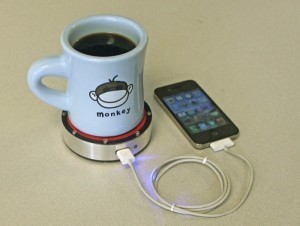Source: earthtechling.com
Published: February 14, 2013
If, like me, you’re seated in front of a computer right now, you, like me, probably have a beverage within arm’s reach. Something about the presence of a hot thermos full of tea says “it’s time to work” for me. You might prefer coffee, or perhaps a cold beverage if you’re lucky enough to live in a tropical climate. Aside from a little comfort and thirst-quenchment, we give our beloved cuppa little regard, but that’s about to change.
Epiphany Labs recently launched a crowdfunding campaign for something called the “onE Puck” on Kickstarter. At first glance it appears to be nothing but a futuristic looking coaster, but what’s this? A USB port on the side! Simply plug in your compatible charger and place a hot (or cold) beverage on the coaster, and it will charge your phone. Seriously.

Image via Epiphany Labs/Kickstarter
Although it seems incredibly high tech, the genius that makes the onE Puck work was actually first conceived in 1816. The Puck uses something called a “stirling engine” which draws power from heat disparities, such as a hot or cold drink, a candle, ice, etc. The Puck has two sides, one red, one blue. Place a hot drink on the red side, or a cold drink on the blue side, and the heat disparity will provide enough power to the stirling engine to fully charge your cell phone battery.
The onE Puck is compatible with all iPhones, iPods, Androids, and pretty much any device that uses a USB charger drawing 1000 mA or less. While the immediate effect will be to change phone charging forever, Epiphany Labs has much bigger plans for this gadget.
“Our vision is to take the knowledge and experiences we gain from perfecting the Epiphany onE Puck and move on to build even larger stirling engines that can power even larger appliances and eventually entire households!” writes the company on Kickstarter. “We’ll also use them to enhance the water units that we developed through Epiphany Solar Water Systems, which will increase their water output AND provide electricity to the people we help.”
